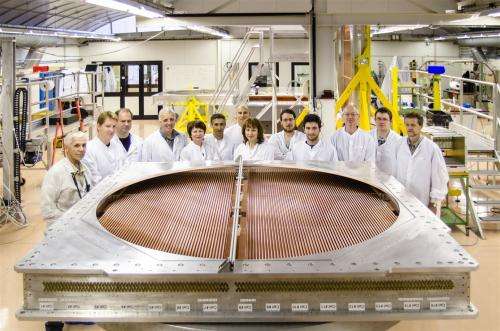CERN: Using 2,000 vacuum-resistant straws to probe new physics

The NA62 straw tracker is using pioneering CERN technology to measure charged particles from very rare kaon decays. For the first time, a large straw tracker will be placed directly into an experiment’s vacuum tank, allowing physicists to measure the direction and momentum of charged particles with extreme precision. NA62 measurements using this technique will help physicists take a clear look at the kaon decay rate, which might be influenced by particles and processes that are not included in the Standard Model.
“Although straw detectors have been around since the 1980s, what makes the NA62 straw trackers different is that, for the first time, they can work under vacuum,” explains Hans Danielsson from the PH-DT group leading the NA62 straw project. Straw detectors are basically small drift chambers, where particles ionize a gas inside a thin tube containing a wire that records a signal and measures the drift time.
After 3 years of research and development, NA62 straws are able to withstand the high pressure exerted by the gas once the straws are placed inside the experiment’s vacuum tank, which is over 100 m long and 2.5 m in diameter. Traditional strategies would have either installed a support structure or increased the thickness of the straws to withstand the pressure. Sound practices, but they would have created an unwanted interaction source for particles in the vacuum. Yet the NA62 straws are mechanically stable for over 2 m while remaining leak-proof in order to preserve the integrity of the vacuum.

The secret of their success was finding a new way to build the straws. “Straw trackers are usually made by winding two conductive tapes in a spiral – rather like the centre of a paper towel roll,” says Hans. “This technique worked well for the ATLAS TRT straw detectors, but it does not make mechanically stable and leak-proof straws.”
Instead, in collaboration with the Joint Institute for Nuclear Research (JINR) in Russia, the team developed a technique whereby a 31 mm wide band is rolled into a straw shape and then welded shut, leaving a single, 0.6 mm thick seam along its length. “We used ultrasonic welding to close the straw,” explains Hans. “We discovered that this welding technique not only made the straws completely leak-proof but also gave them the strength to keep them straight and withstand the vacuum pressure without breaking.”
With R&D complete, the NA62 straw tracker is making its way down the assembly line at CERN. Around 2000 straws are now being assembled into eight modules. Every module has eight rows of straws, and each row is rotated 90 degrees to ensure that at least two coordinates are measured for each particle. The eight modules will be installed in the vacuum tank at four different locations.
“We’re testing every straw individually, fitting them into the modules and connecting the electronics,” says Hans. “Of course, we also have to check the modules at every step of assembly to make sure they meet the strict specifications of the detector. A team from the JINR is working with us for a few weeks. They are learning the different steps of module assembly, and should assemble some of the modules back at their home institute.”
Source: CERN

















